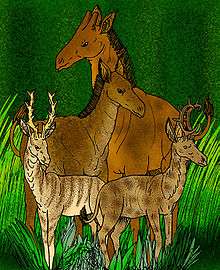Climacoceras
| Climacoceras Temporal range: Miocene | |
|---|---|
 | |
| Comparison of Palaeotragus with two species of Climacoceras (in the foreground) | |
| Scientific classification | |
| Kingdom: | Animalia |
| Phylum: | Chordata |
| Class: | Mammalia |
| Order: | Artiodactyla |
| Family: | †Climacoceratidae |
| Genus: | Climacoceras MacInnes, 1936 |
| Species | |
| |
Climacoceras (from Greek, "Ladder Horns") was a genus of early Miocene artiodactyl ungulates of Africa and Europe. The members of Climacoceras were related to giraffes, as the genus was once placed within Giraffidae. Fossils of the two best known species of Climacoceras, C. africanus and C. gentryi have been both found in Kenya. The animals measured about 1.5 m in height and had large ossicones resembling antlers. C. africanus had ossicones resembling tall thorn-covered plant stems, while the ossicones of C. gentryi resembled thorny crescents.
The genus was once placed within Palaeomerycidae, and then within Giraffidae, it is now considered a giraffoid and a new family, "Climacoceratidae," has been erected by Hamilton for this genus.
Other Climacoceratidae include Prolibytherium from Egypt and Libya and Orangemeryx from Namibia and South Africa.
References
- MacInnes, D. G. 1936, "A new genus of fossil deer from the Miocene of Africa", Journal of the Linnean Society, Zoology 39: 521-530.
- Hamilton, W. R., 1978, "Cervidae and Palaeomerycidae", 495-508, in Maglio, V. J. & Cooke, H. B. S., (eds.) "Evolution of African mammals", Harvard University Press, Cambridge, Massachusetts & London, England, 1978, xiv-641